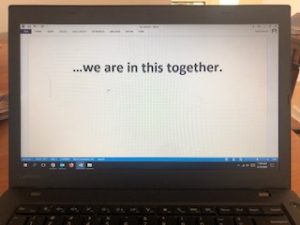Structured Flexibility
April 10, 2020 - 6 minutes readThe shift to remote learning from regular in-school instruction happened quickly. Fortunately, spring break in British Columbia landed at an opportune time, affording schools the time needed to develop and mobilize plans for this different mode of teaching and learning. Without a road map we felt like pioneers, forging ahead thoughtfully and with care, taking direction from the Ministry of Education and guidance from our school district leaders. Collaboration at all levels was essential and I could not be more proud of how we have come together to develop plans to support our students and families throughout these worrisome, unusual times.
A fair amount of progress has been made in a mere two weeks. Communicating regularly and connecting with our families has been a priority as we recognize the challenges many may be facing. As we receive feedback from our students and parents, we adapt our plans as needed. Being ‘nimble’ (credit goes to Dr. Bonnie Henry for that word) in these extraordinary circumstances has been crucial at the outset as we hope to engage students and not deter or overwhelm them.
Not surprisingly, students vary in how well they are coping with remote learning. Many are missing being affiliated with school clubs, belonging to sports teams, learning alongside peers, and connecting in person with friends and staff members. Some students are struggling to ‘get going’ and need encouragement to organize their learning tasks. We are also hearing that some learners who are easily distracted at school for a variety of reasons are experiencing success at home. They feel empowered by this ‘structured flexibility’ and are responding well to having choice in how, what and when they learn.
When organizing the variety of learning opportunities provided by their teachers, students are the decision-makers. In my live broadcast to families, I encouraged students to think about their unique learning style.
“What is your optimal time to be learning? In other words, when do you learn best? Are you an early riser or do you like to sleep in? Are you able to concentrate for fairly long periods or do you need frequent breaks? With remote learning, you can organize when and how you do your learning activities. For example, you may prefer to do all your English on one day and Math on the next….or you may want to do a little bit each day. Look at your weekly learning plans and using 2-3 hours/day as a guideline, plan your time and manage your learning.”
As a youth, I enjoyed playing a variety of sports which involved hours of practising and training. My track and field coach was masterful at designing different workouts for us. I recall having to run grueling 300m intervals on the track. These were simply not fun. The fact I still remember them after all these years tells you something! I much preferred a different kind of training called ‘Fartlek’, a Swedish term that means ‘speed play’. (Yes, I recognize it’s a bit of a strange word!)
If you haven’t heard of Fartlek, it is an effective training method designed to improve speed, endurance and mental strength. And it is far more interesting (and playful) than interval training in my humble opinion. Unlike running intervals on a track, Fartlek training offers more flexibility and choice. On different types of terrain, runners alternate their pace, running with intensity for some segments and slower for others. Fartlek training was never boring for me as I was in the driver’s seat, controlling the length of each burst of speed and deciding how long the slow-paced segments would be based on my energy levels that day.
Remote learning reminds me of Fartlek training. In both of these activities, participants have the flexibility to set the parameters of their sessions. They can alternate between challenging and easier tasks and take breaks as needed to improve their stamina, all the while reducing their levels of stress and improving their mental well-being.
While learning remotely, students have an opportunity to practise their self-management skills. We have been working on these important life skills at Rockridge with all of our students. Inserting Flexible Instructional Time (FIT) into the daily schedule at our secondary schools this year was a strategy designed to provide students with time to meet their particular needs. They decide, for example, whether to access teachers for support, collaborate with their peers on projects, or shoot hoops in the gym. Students are in charge of how they use this half hour of time each day. In current circumstances, our learners have FIT all day every day. Perhaps a positive outcome of remote learning will be students with improved time management and organizational skills! 
We are looking forward to the return of in-school instruction, yet will certainly be reflecting on the lessons learned from remote learning. In the meantime, Rockridge staff members are ‘behind the screens’, available to help students manage this ‘structured flexibility’. Never hesitate to reach out as you have heard repeatedly…
Recent Comments